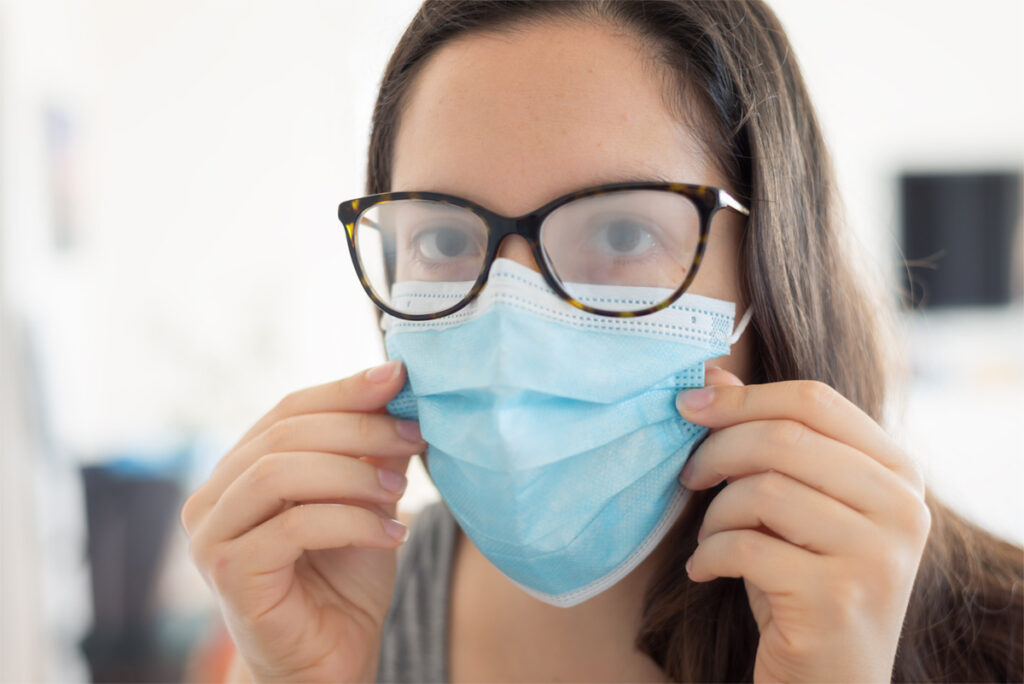 Leaving your house these days means a whole new normal. Needing to make sure if you have your mask, your gloves, and hand sanitizer? Now because of masks, millions of eyeglass wearers are discovering the annoyance of mask-induced foggy lenses.
Leaving your house these days means a whole new normal. Needing to make sure if you have your mask, your gloves, and hand sanitizer? Now because of masks, millions of eyeglass wearers are discovering the annoyance of mask-induced foggy lenses.
Why do glasses fog up in the first place?
Here’s the simple science behind it. When warm air hits a cool surface, condensation can form. When your warm moist breath escapes through the top of the mask, it hits the lenses of your glasses and causes them to fog up. While we can’t control what’s going on around us, the good news is, we can eliminate the foggy glasses problem. Here are a few helpful tips.
1. Wash your glasses in soapy water
Wash your glasses or sunglasses lenses with soapy water and shake off the excess moisture. Let your glasses air dry or gently dry the lenses with a clean microfiber cloth.
Using this method, the lenses shouldn’t fog up once you put on the mask and glasses because cleaning the lenses with soapy water leaves thin film. To avoid damage, don’t clean your lenses with products like toothpaste or shaving cream.
2. Make sure the mask fits well
When a face mask fits correctly, it should fit snugly against your face. You should not have air going out the top. A loose-fitting mask lets exhaled air travel toward your glasses, but a snugly fitting mask can shoot that air out of the bottom or sides of the mask and away from your glasses.
If it feels too loose, you can adjust the ear loops or the ties so that the mask fits more snugly. If you feel any air going in or out of your mask, that’s another sign that it’s too loose and needs to be tightened.
For a better fit, use masks equipped with moldable pieces around the nose (such as a metal strip) or masks that come in various sizes.
3. Seal/tape your mask (carefully)
Going along the same lines as making sure your mask fits properly, another tip that doctors use is tape to prevent their glasses from fogging up. Be sure to test the tape on a different part of your body to make sure you are not allergic. If you don’t break out in hives or any other concerning symptoms, you can move on to taping your mask. You can use almost any kind of tape, but stay away from duct tape, and packing tape to be safe. Once you’ve found a safe kind of tape, you can tape your mask across the bridge of your nose, as well as across your cheeks.
One important thing to know is if the tape doesn’t work for you, it may be because of any anti-glare, anti-fingerprint, or anti-smudge coatings that you have on your glasses already. There are special antifog wipes for these anti-glare coated lenses (Hilco – OptiPlus Lens Wipes).
4. Tuck a small tissue into the mask
Attaching a small tissue to the inside of the mask will absorb moisture that otherwise would find its way to the lenses. Place a folded tissue at the top of your mask and tape it there.
5. Adjust your glasses
If your glasses have nose pads, you can tweak the pads so that the frames sit slightly farther from your face, this will allow that hot air to escape instead of getting trapped between your face and the lenses of the glasses.
By altering the nose pads there may be a slight change in your vision if you wear glasses with progressive lenses or lenses with a strong prescription. If that happens, you might need to hold your head at a different angle to compensate for the vision change.
6. Use de-fogging products
Applying over-the-counter anti-fogging sprays, waxes and gels to your non-coated lenses before putting on your glasses can quickly disperse tiny fog droplets when you’re wearing a mask. Some work better with different body chemistry, so you may need to try a few brands to see which one works best for you.
Do not use anti-fogging products made for cars or other purposes, as they may ruin your prescription lenses.
7. Breathe downward
Well, it might be awkward, but breathing downward can be a quick anti-fog fix, this sends the air away from your glasses. Breath downward by holding your upper lip over your lower lip. Then blow air downward, as if you’re playing a flute.
8. Check Out Anti-Fog Lenses
For a more permanent solution, you could consider buying lenses made with anti-fog coating that gives you a hassle-free answer to foggy lenses, regardless of whether the obstructed vision is triggered by a face mask or something else.

